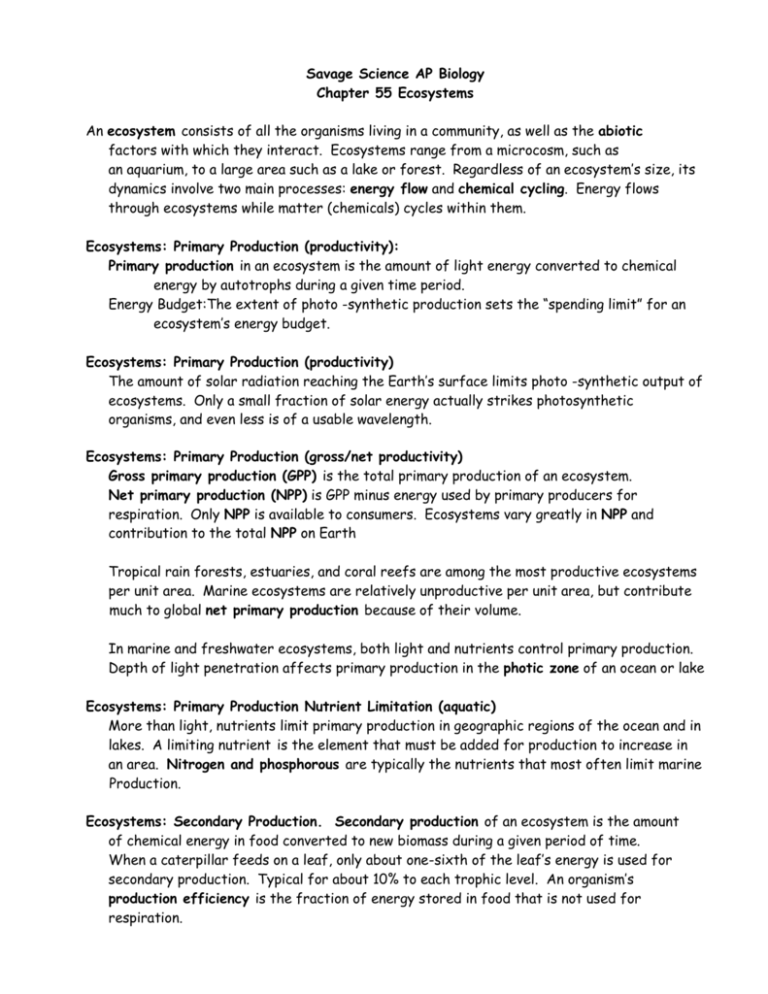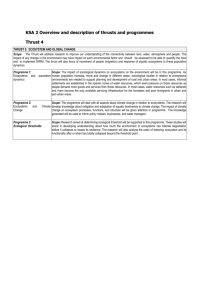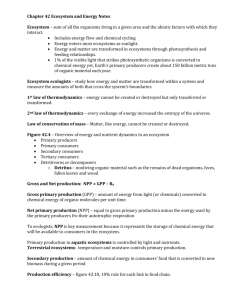Ecosystems: Primary Production (productivity)
advertisement

Savage Science AP Biology Chapter 55 Ecosystems An ecosystem consists of all the organisms living in a community, as well as the abiotic factors with which they interact. Ecosystems range from a microcosm, such as an aquarium, to a large area such as a lake or forest. Regardless of an ecosystem’s size, its dynamics involve two main processes: energy flow and chemical cycling. Energy flows through ecosystems while matter (chemicals) cycles within them. Ecosystems: Primary Production (productivity): Primary production in an ecosystem is the amount of light energy converted to chemical energy by autotrophs during a given time period. Energy Budget:The extent of photo -synthetic production sets the “spending limit” for an ecosystem’s energy budget. Ecosystems: Primary Production (productivity) The amount of solar radiation reaching the Earth’s surface limits photo -synthetic output of ecosystems. Only a small fraction of solar energy actually strikes photosynthetic organisms, and even less is of a usable wavelength. Ecosystems: Primary Production (gross/net productivity) Gross primary production (GPP) is the total primary production of an ecosystem. Net primary production (NPP) is GPP minus energy used by primary producers for respiration. Only NPP is available to consumers. Ecosystems vary greatly in NPP and contribution to the total NPP on Earth Tropical rain forests, estuaries, and coral reefs are among the most productive ecosystems per unit area. Marine ecosystems are relatively unproductive per unit area, but contribute much to global net primary production because of their volume. In marine and freshwater ecosystems, both light and nutrients control primary production. Depth of light penetration affects primary production in the photic zone of an ocean or lake Ecosystems: Primary Production Nutrient Limitation (aquatic) More than light, nutrients limit primary production in geographic regions of the ocean and in lakes. A limiting nutrient is the element that must be added for production to increase in an area. Nitrogen and phosphorous are typically the nutrients that most often limit marine Production. Ecosystems: Secondary Production. Secondary production of an ecosystem is the amount of chemical energy in food converted to new biomass during a given period of time. When a caterpillar feeds on a leaf, only about one-sixth of the leaf’s energy is used for secondary production. Typical for about 10% to each trophic level. An organism’s production efficiency is the fraction of energy stored in food that is not used for respiration. Ecosystems: Biogeochemical processes: Life depends on recycling chemical elements. Matter not created or destroyed. Nutrient circuits in ecosystems involve biotic and abiotic components and are often called biogeochemical cycles Ecosystems: Biogeochemical processes: Gaseous carbon, oxygen, sulfur, and nitrogen occur in the atmosphere and cycle globally. Less mobile elements such as phosphorus, potassium, and calcium cycle on a more local level. A model of nutrient cycling includes main reservoirs of elements and processes that transfer elements between reservoirs. All elements cycle between organic and inorganic reservoirs Ecologists focus on four factors with cyclical chemicals: 1) Each chemical’s biological importance. 2) Forms in which each chemical is available or used by organisms. 3) Major reservoirs for each chemical. 4) Key processes driving movement of each chemical through its cycle.









